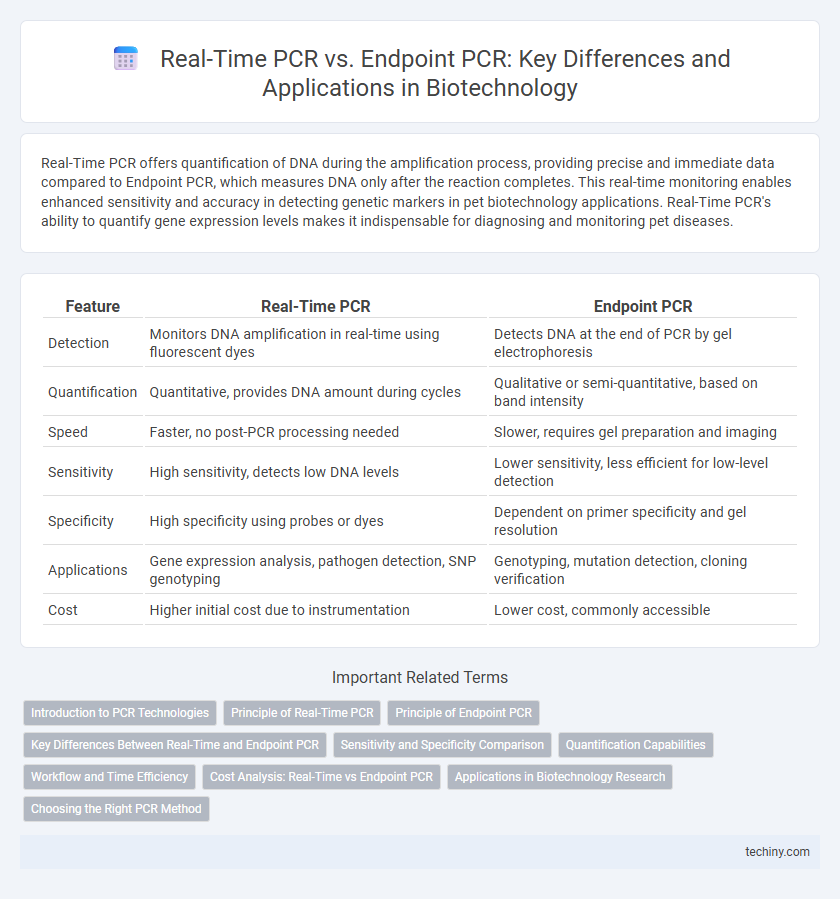Real-Time PCR offers quantification of DNA during the amplification process, providing precise and immediate data compared to Endpoint PCR, which measures DNA only after the reaction completes. This real-time monitoring enables enhanced sensitivity and accuracy in detecting genetic markers in pet biotechnology applications. Real-Time PCR's ability to quantify gene expression levels makes it indispensable for diagnosing and monitoring pet diseases.
Table of Comparison
| Feature | Real-Time PCR | Endpoint PCR |
|---|---|---|
| Detection | Monitors DNA amplification in real-time using fluorescent dyes | Detects DNA at the end of PCR by gel electrophoresis |
| Quantification | Quantitative, provides DNA amount during cycles | Qualitative or semi-quantitative, based on band intensity |
| Speed | Faster, no post-PCR processing needed | Slower, requires gel preparation and imaging |
| Sensitivity | High sensitivity, detects low DNA levels | Lower sensitivity, less efficient for low-level detection |
| Specificity | High specificity using probes or dyes | Dependent on primer specificity and gel resolution |
| Applications | Gene expression analysis, pathogen detection, SNP genotyping | Genotyping, mutation detection, cloning verification |
| Cost | Higher initial cost due to instrumentation | Lower cost, commonly accessible |
Introduction to PCR Technologies
Real-Time PCR quantifies DNA amplification in real time using fluorescent markers, allowing for precise measurement during each cycle, whereas Endpoint PCR detects DNA only after cycling completion. Real-Time PCR offers enhanced sensitivity, specificity, and quantification, making it ideal for diagnostic and gene expression studies. Endpoint PCR remains valuable for qualitative analysis and cloning but lacks the dynamic data output provided by Real-Time PCR.
Principle of Real-Time PCR
Real-Time PCR, also known as quantitative PCR (qPCR), quantifies DNA amplification in real-time by measuring fluorescence emitted during each PCR cycle, enabling precise detection of nucleic acids. This technique utilizes fluorescent dyes or probes that bind specifically to target DNA sequences, allowing continuous monitoring of DNA synthesis without the need for post-PCR analysis. Real-Time PCR's principle allows for accurate quantification, high sensitivity, and rapid results, making it essential for gene expression studies, pathogen detection, and genotyping.
Principle of Endpoint PCR
Endpoint PCR relies on the amplification of target DNA sequences through repeated thermal cycling, with the final product analyzed after the completion of all cycles using techniques such as gel electrophoresis. This method detects amplified DNA qualitatively or semi-quantitatively, measuring the presence or absence of the target sequence at the reaction's endpoint rather than during the amplification process. Unlike Real-Time PCR, Endpoint PCR does not provide dynamic or quantitative data on amplification kinetics, limiting its use in precise quantification applications.
Key Differences Between Real-Time and Endpoint PCR
Real-Time PCR quantifies DNA amplification during the exponential phase, providing immediate, quantitative data by measuring fluorescence signals, whereas Endpoint PCR detects DNA only after the reaction is complete through gel electrophoresis. Real-Time PCR offers higher sensitivity and specificity due to its ability to monitor amplification in real-time, enabling precise quantification of nucleic acids. Endpoint PCR is limited to qualitative analysis, making Real-Time PCR the preferred method in diagnostic and research applications requiring accurate DNA quantification.
Sensitivity and Specificity Comparison
Real-Time PCR offers higher sensitivity by detecting DNA amplification during exponential phases, enabling quantification of low-abundance targets with precise fluorescence monitoring. Endpoint PCR provides qualitative results post-amplification, which can limit sensitivity and specificity due to reliance on gel electrophoresis and potential primer-dimer interference. The real-time detection in qPCR reduces false positives and enhances specificity by discriminating target sequences using sequence-specific probes or melting curve analysis.
Quantification Capabilities
Real-Time PCR offers superior quantification capabilities by measuring DNA amplification during each cycle, enabling precise, dynamic quantification of nucleic acids. Endpoint PCR detects DNA only after amplification completion, limiting it to qualitative or semi-quantitative analysis. The sensitivity and accuracy of Real-Time PCR make it essential for gene expression studies, viral load monitoring, and diagnostic applications.
Workflow and Time Efficiency
Real-Time PCR offers continuous monitoring of DNA amplification, significantly reducing overall analysis time compared to Endpoint PCR, which requires post-amplification processing. The streamlined workflow of Real-Time PCR eliminates the need for gel electrophoresis, enhancing laboratory efficiency by providing immediate quantification and results. This time-efficient approach is critical in high-throughput settings and clinical diagnostics, where rapid decision-making is essential.
Cost Analysis: Real-Time vs Endpoint PCR
Real-Time PCR typically incurs higher initial costs due to advanced instrumentation and fluorescent probes, whereas Endpoint PCR requires less expensive equipment and reagents. However, Real-Time PCR reduces labor and time expenses by providing immediate quantification and minimizing post-PCR processing. Overall, Endpoint PCR offers a lower upfront investment, but Real-Time PCR can deliver cost-efficiency for high-throughput or quantitative applications.
Applications in Biotechnology Research
Real-Time PCR enables precise quantification of gene expression levels, making it indispensable for applications such as gene expression profiling, pathogen detection, and genotyping in biotechnology research. Endpoint PCR, while useful for determining the presence or absence of target DNA sequences, lacks quantitative capabilities and is primarily employed in cloning, mutation analysis, and routine screening. The real-time monitoring of amplification dynamics in Real-Time PCR offers enhanced sensitivity and specificity, which accelerates advancements in molecular diagnostics and therapeutic development.
Choosing the Right PCR Method
Real-Time PCR offers precise quantification of nucleic acids through fluorescence detection during amplification, making it ideal for applications requiring accurate gene expression analysis or pathogen quantification. Endpoint PCR is suitable for qualitative detection where the presence or absence of target DNA is sufficient, often used in routine diagnostics or genotyping. Selecting the appropriate PCR method depends on experimental goals, with Real-Time PCR providing sensitivity and quantitation, while Endpoint PCR offers simplicity and cost-effectiveness.
Real-Time PCR vs Endpoint PCR Infographic

 techiny.com
techiny.com